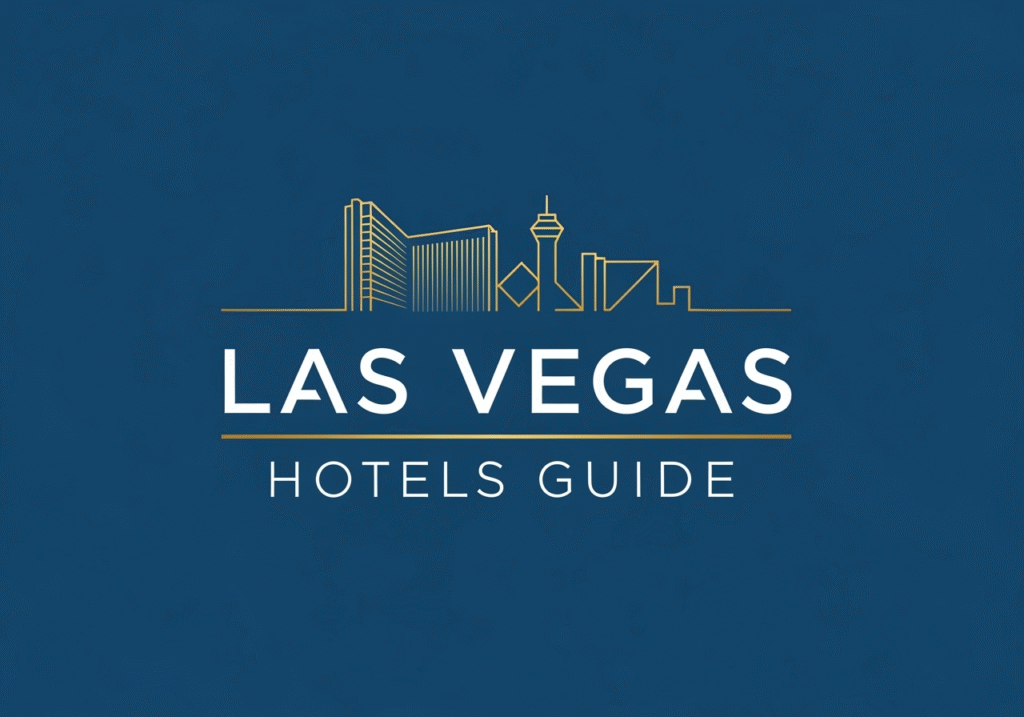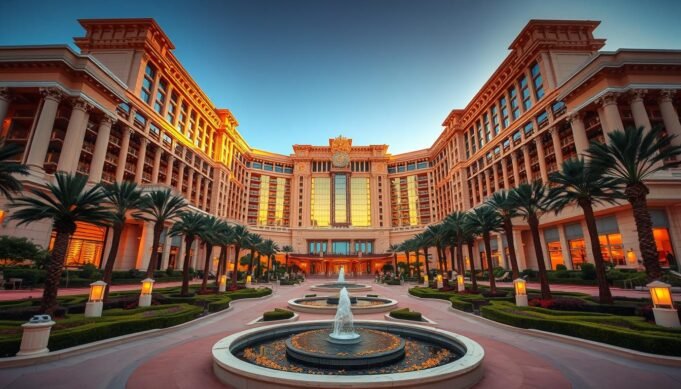I’ve stayed in some jaw‑dropping suites, and the Strip still knows how to surprise. From art‑dripped penthouses to private pools that float above city lights, a few properties set the bar for what luxury can be.
Here I’ll show what makes the most expensive hotel in las vegas worth your time—think skyline terraces, custom service that reads your next move, and rooms that photograph like magazine covers.
I’ll compare average per night rates at signature resorts world spots and long‑running icons, note when suites justify the splurge, and point you to options that match your vibe—design forward, party ready, or quietly opulent.
If you want crisp, editorial photography direction and real numbers to plan a night you’ll never forget, stick with me. Also, check out a curated guide to New Year’s stays for planning big nights on the Strip at best Las Vegas hotels for New Year’s.
Key Takeaways
- Top suites blend bold design with ultra‑personal service.
- Average nightly rates vary widely across the vegas strip and resorts world choices.
- Special‑occasion suites add amenities that can justify steep per night prices.
- Midweek stays and event timing change the real cost for guests.
- Editorial‑style photos help set realistic expectations before you book.
Why Las Vegas Commands Sky‑High Nightly Rates Right Now
I watch pricing like a pulse—fast, reactive, and telling. One headline residency or a major game can send demand spiking across the Strip. When suites sell out first, entry rooms follow. That’s how the market works: limited inventory meets big, sudden demand.
Renovations, fresh restaurants, and buzzy shows add fuel. Resorts World openings and marquee debuts create a halo effect that lifts nearby properties. Encore and Wynn often lead the pack on average rates, followed by Palazzo, Venetian, Bellagio, Caesars Palace, and NoMad.
The same room feels different depending on time: mid‑week stays can be soft, while Fridays flip pricing hard. Conventions pack meeting space and push rooms across categories. I plan around calendars because small date shifts save dollars without sacrificing the experience.
- Headliners, sports, and conventions—instant rate surges.
- Renovations and new amenities—perceived value rises.
- Proximity to major venues—nearby hotels feel the lift.
| Property | Typical Average Rate | Demand Drivers |
|---|---|---|
| Encore | $673.70 | Pools, shopping, high‑end dining |
| Wynn | $638.70 | Refreshed rooms, signature shows |
| Palazzo / Venetian | $454.40 / $428.80 | Suite baseline, central entertainment |
| Bellagio / Caesars Palace | $428.60 / $389.40 | Fountains, restaurants, large pools |
How We Ranked the Most Expensive Stays on the Strip
I kept the test simple so the numbers tell the story. Ten matched nights across properties, baseline rooms only, and resort fees baked into every total. That gives a clean average per night that you can trust when comparing dates and value.
Methodology
The sample: ten randomly selected nights that mix weeknights and weekend peaks. Same dates for every property. Same standard rooms. Resort fees included so totals are comparable.
Variables that Swing Rates
- Conventions, arena concerts, and big sporting events drive sudden jumps.
- Renovations and new restaurant openings lift perceived value and average rates.
- Credit card promos and loyalty offers can shave the final bill—useful, but not part of the core per night math.
- Features like private pools or butlers matter for upgrades, but the ranking starts with comparable rooms first.
“An apples‑to‑apples baseline shows where real premium lives—then features explain the rest.”
Photography notes: keep interiors crisp and evenly lit (f/4, ISO 100), with editorial framing that leads the eye through a room. That visual consistency helps you judge true value at the time you book.
The Most Expensive Hotel in Las Vegas: Suites That Redefine Luxury
If you want suites that feel like private museums or rooftop sanctuaries, this list is where to start. Below are the headline keys — rooms with scale, art, and service that read like experiences.
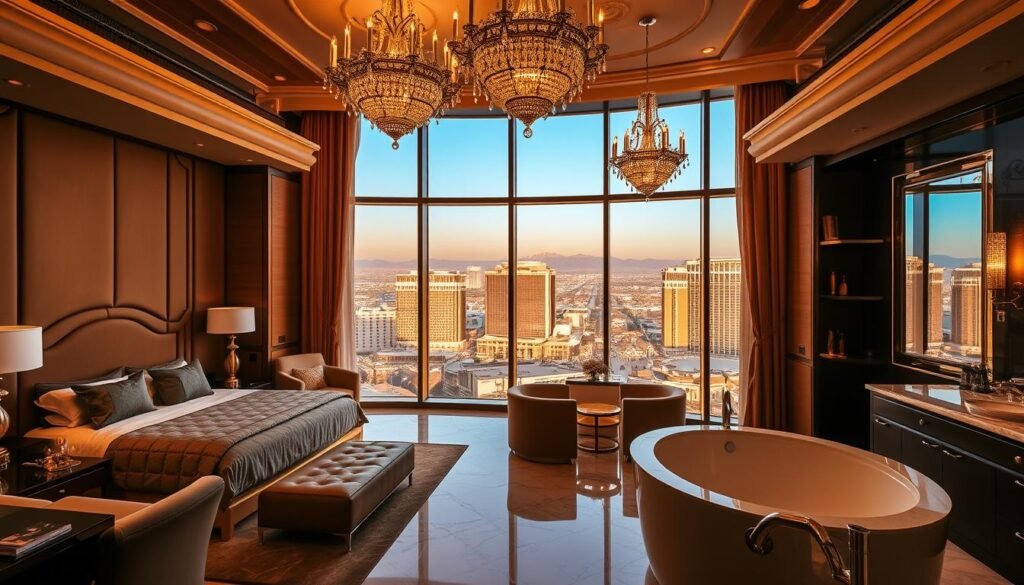
Palms Casino Resort — Empathy Suite
$75,000 per night, 9,000 square feet. Damien Hirst originals, a terrace pool, two massage rooms, and a sauna. It’s theatrical, private, and built for spectacle.
Nobu Hotel at Caesars Palace — Nobu Villa
$40,000 per night, 10,300 square feet. Private elevator, rooftop Zen garden whirlpool, gym, and a calm wood-and-stone palette that feels like a retreat.
Caesars Palace — Constantine Villa
$35,000 per night, ~10,000 square feet. Private theater and a hot-tub terrace overlooking the garden complex — ideal for groups who want both show and seclusion.
- The Cosmopolitan — Boulevard Penthouses: up to $30,000 per night, high-floor design magazine vibes and Reserve salon access.
- Crockfords at Resorts World — Palace Suite: private garden and pool, hush‑list VIP choreography.
- Venetian/Palazzo — Chairman’s Suite: ~6,000 square feet, invite-only with private pool and butler service.
“Photograph each suite like an editorial cover — golden hour, tack-sharp, and HDR to keep marble and city light true.”
Average Rate Heavyweights on the Strip: Where Baseline Rooms Still Cost a Premium
Baseline rooms can surprise you; I mapped out where the Strip charges more and what you actually get.
Encore — ~$673.70 per night. Sits on the north end strip with upscale pools, shopping, and dining. Even entry rooms feel aggressive on size and finish.
Wynn — ~$638.70 per night
Refreshed rooms and the “Awakening” theater experience push rates up. Pair a show and dinner and the per night math starts to make sense.
Palazzo / The Venetian — $454.40 / $428.80 per night
Palazzo baseline suites are ~720 sq ft; Venetian about 650 sq ft. Both deliver separate living areas that actually function—not just for photos.
Bellagio / Caesars Palace — $428.60 / $389.40 per night
Bellagio’s refreshed rooms and fountain access remain timeless. Caesars leans on food and spectacle—Bacchanal Buffet and the Garden of the Gods pool tilt the scale for many.
NoMad at Park MGM — ~$364.50 per night
NoMad offers boutique luxury on a non‑smoking resort campus. It’s a stealth pick for travelers seeking style without sensory overload.
- Quick take: Encore and Wynn lead las vegas averages for a reason—location, polish, and amenities.
- Palazzo and Venetian win on baseline square footage and usable layouts.
- Use wide editorial frames (f/4) and golden hour exteriors to judge actual room proportions and features.
“These are the hotels where even the basic keys feel posh—book with expectations set on space and service.”
Other Luxury Strip Resorts Worth Considering for Value
If you’re chasing high value without headline prices, a few Strip resorts quietly deliver big returns on comfort and service.
Resorts World — Crockfords sits on the north end and often posts averages near $252.72 per night. The entrance feels boutique, service is polished, and the public spaces photograph beautifully at golden hour.
South‑Strip Retreats: Mandalay Bay & Delano
Mandalay Bay (~$298.50 per night) and Delano (~$354.20) trade center‑stage energy for calmer location and quiet lounges.
They make a great retreat after a long day of shows. Hop the tram north when you want action.
Center‑Strip Tech: Aria
Aria averages about $337.50 per night. The rooms feel smart—touch panels and clean lines—perfect when you want a center‑of‑everything location and modern in‑room tech.
Suite‑Style Simplicity: Vdara
Vdara (~$286.30) offers kitchenette studios and no casino floor. That kitchenette is underrated—coffee how you like it, quick snacks, and a short walk to Aria for dining and pool time.
- Value tip: Crockfords at resorts world gives newness and gentler averages than headline names.
- Stitch stays: start quiet at Delano, finish loud at Aria for a balanced long‑weekend.
- Price‑to‑finish here wins—serious dining, great pools, and high‑touch amenities without tier‑one sticker shock.
| Property | Average per Night | Why Choose It |
|---|---|---|
| Crockfords at Resorts World | $252.72 | Quiet north end location, boutique service, lower averages |
| Mandalay Bay | $298.50 | South‑Strip calm, big pool complex, resort feel away from center |
| Delano | $354.20 | Quiet suites, refined lounges, ideal for downtime |
| Aria | $337.50 | Tech‑forward rooms, center‑strip convenience, easy dining options |
| Vdara | $286.30 | Kitchenette studios, no casino, short walk to Aria pools and dining |
“Price‑to‑finish matters. You can get real luxury without the top‑tier sticker shock.”
Downtown’s Priciest Pick: Circa on Fremont Street
Circa feels like downtown amplified—loud, bright, and built for a crowd that wants energy. I pick it when I want a day by a rooftop pool with stadium vibes and a sportsbook that reads like an arena.
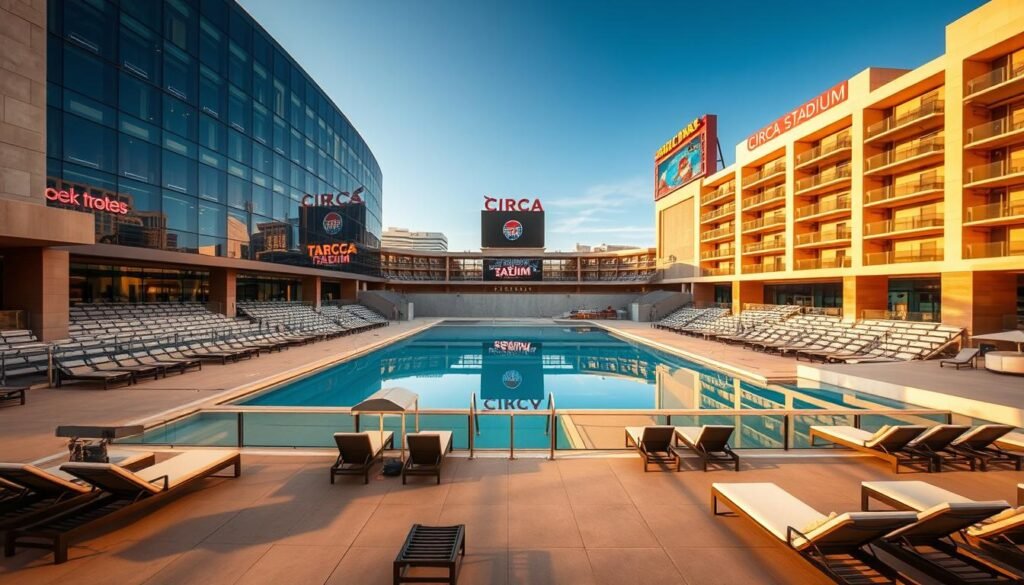
Quick snapshot: average about $230.78, but still cheaper than strip peers. The rooftop Stadium Swim is part pool, part amphitheater. Daylight shots should be energetic—diffused sun, HDR to hold water highlights and the giant video screen.
Signature draws
- Stadium Swim: an amphitheater pool that stages daytime energy and DJ sets.
- Three‑story sportsbook: cathedral‑scale screens, tack‑sharp typography, and led panels that make every play feel huge.
- Vegas Vickie: the restored neon is a photo stop that nods to classic las vegas.
Rooms run cheaper per night than many strip options, but the buzz feels like a full‑tilt trip. Claim a seat at the sportsbook, check the odds at your table, then cool off by the pool.
| Feature | Detail | Why it matters |
|---|---|---|
| Average rate | $230.78 | Downtown value with big‑city energy |
| Stadium Swim | Rooftop pool amphitheater | Day parties, strong photo moments |
| Sportsbook | Three stories, massive screens | Game day atmosphere, social watching |
“It’s a solid pivot if you want one foot in classic las vegas and one in new‑build swagger.”
Inside Resorts World Las Vegas: The Most Expensive Resort Build Ever on the Strip
Walking into Resorts World feels like stepping into a city within a city—big, bright, and engineered for spectacle.
Opened June 24, 2021, this $4.3B development was the first new resort on the Strip since 2010. The 59‑story tower holds 3,506 rooms across three brands: Las Vegas Hilton (1,678), Conrad (1,496), and Crockfords (332).
The casino spans about 117,000 square feet with wide aisles and crisp lighting. The five‑acre pool complex stretches out like a park. A 5,000‑seat theater anchors headline nights and residency drops.
The exterior video canvas wraps roughly 100,000 square feet of LED. The retail district adds ~70,000 square feet of shops and restaurants. A Convention Center Loop station links meetings to leisure fast.
I still remember opening week—the scale hits first, then the polish. Design by Steelman Partners leans lightly East‑Asian, with sculptures and art that reward tack‑sharp frames.
- Photo tips: 8K RAW, HDR for LED surfaces; golden hour exteriors; interiors shot at f/4 to lead the eye.
- Why it matters: The property feels future‑proof—layered restaurants, a massive video façade, and convention connectivity that change the game on the vegas strip.
“It’s the kind of addition the Strip needed—bold, connected, and built to last.”
North End vs. Center Strip: Location, Theme, and Guest Experience
Walk the strip and you’ll feel two different beats: the north end’s calm polish versus the center’s headline energy.
I favor the north for stays that feel curated. Resorts World and the Wynn/Encore cluster bring newer design, quieter sidewalks, and roomy public areas. That gives you elbow room and a chance to settle into a single resort as a base.
The center strip, by contrast, is the classic postcard—fountains, grand entries, and a dense web of dining and gaming options. If you want quick hops to restaurants, shows, and the Bellagio water display, center wins on convenience.
- North end: sleeker design, quieter walks, newer builds, strong resort amenities and punchy dining at select venues.
- Center strip: immediate access to high-density dining, venue-hopping gaming, and iconic photo moments.
If your travel style is to explore everything each day, choose center. If you prefer a refined home base with roomy public spaces and newer touches, the north end shines.
| Feature | North End | Center Strip |
|---|---|---|
| Typical vibe | Curated, calm, modern | Iconic, busy, concentrated |
| Anchor resorts | Wynn / Encore, Resorts World | Bellagio, Caesars, Venetian / Palazzo, Aria |
| Dining | High‑quality, punchy options at new venues | Dense choices, quick table turns, celebrity spots |
| Gaming style | Settle into one casino, relaxed play | Venue-hop, see-and-be-seen energy |
“Pick location by how you want to spend your day—close to everything, or settled and stylish.”
Suites vs. Standard Rooms: Space, Views, and VIP Inclusions
When you step into a full suite, the stay shifts from transient to residential—space, staff, and features that keep you there longer.
Standard rooms today are solid: tidy layouts, good bedding, and reliable views. But a suite is a different rhythm. It gives separate living zones, larger windows, and a sense of privacy that changes how you spend your day.
When a butler, private pool, and salon access change the experience
- Butlers time arrivals, prep the room, and make transitions feel effortless.
- Private plunge pools or terrace pools make mornings quietly cinematic.
- Reserved salon or gaming access—like Reserve at The Cosmopolitan—moves you through crowds faster.
High‑end suites can include wellness rooms, private terraces, and dedicated concierge teams. If you’re celebrating, the per night math often favors a suite over piecemeal upgrades.
“Ask exactly what’s included—airport transfers, spa credits, and reserved access often define the true value.”
| Feature | Standard Room | Suite |
|---|---|---|
| Space (sq ft) | 300–450 | 800–10,000+ |
| Service | Front desk concierge | Dedicated butler / private concierge |
| Private Outdoor | Balcony (rare) | Terrace pool / plunge |
| VIP Perks | Occasional upgrades | Salon/gaming access, transfers, spa credits |
Dining, Gaming, and Entertainment: Signature Features That Justify the Price
When dinner and curtain time line up, the whole stay clicks. I plan nights around theater schedules because a late dinner before a show changes the flow of the evening. Book a fountain‑view table at Bellagio and let the water become part of your meal.
Restaurants here are half food, half performance. The Cosmopolitan clusters buzzworthy spots where chefs stage courses like acts. At resorts world the dining list spans casual bites to Zouk Group energy—book windows and ride the light.
Gaming is part social hour, part choreography. Some casinos feel intimate; others glow under chandeliered ceilings and draw a crowd. I choose a corner when I want quiet, or chase the floor energy when I want the pulse.
Art and sculpture anchor a resort’s identity. The Chihuly ceiling at Bellagio and stand‑alone pieces in lobbies demand a slow look—and they shoot beautifully under warm 3500–4500K light with HDR.
- Theaters set the evening: time dinner around curtain calls for a seamless night.
- Late‑night restaurants: great meals often happen after midnight—don’t skip them.
- Amenities and rooms: top dining and casino design often explain why a resort command higher rates.
“Big‑ticket dining is half feast, half theater—book the view and let the city perform.”
For a fresh take on quieter stays and smoke‑free options that still deliver great dining and pool time, check this short guide: best smoke-free hotels in Las Vegas.
Pools, Spas, and Wellness: Daytime Luxury on the Las Vegas Strip
Daylight around water changes everything—choose a pool scene that fits how you want to spend your afternoon.
I map my day by light and temperature. Multi‑acre complexes—Resorts World’s five acres among them—offer zones for sun, shade, and music. Pick a calm lap lane or a lively pool deck depending on mood.
Spa time resets the evening. Steam, sauna suites, and long showers clear travel fog. Many top resorts fold in in‑room treatments for privacy, or full programs with recovery therapies and daylight gyms.
Guests who book villa space with a private pool get true sanctuary—quiet laps, coffee on a lounger, then the city later. Look for wellness‑forward amenities like recovery rooms, daylight fitness, and massage‑on‑demand.
- Day plan tip: schedule an early swim and mid‑afternoon spa—your night will feel effortless.
- Photo tip: shoot at f/4 for soft depth, warm skin tones, and balanced water highlights.
“Soft daylight and calm spaces make daytime the most memorable part of a stay.”
Booking Strategy: Dates, Events, and How to Time Your Stay
Timing beats luck—small date moves or event avoidance can save hundreds on a single night.
I watch calendars before I lock anything. Conventions and big games push rates across many hotels at once. If you can, avoid headline weekends and aim for quieter slots.
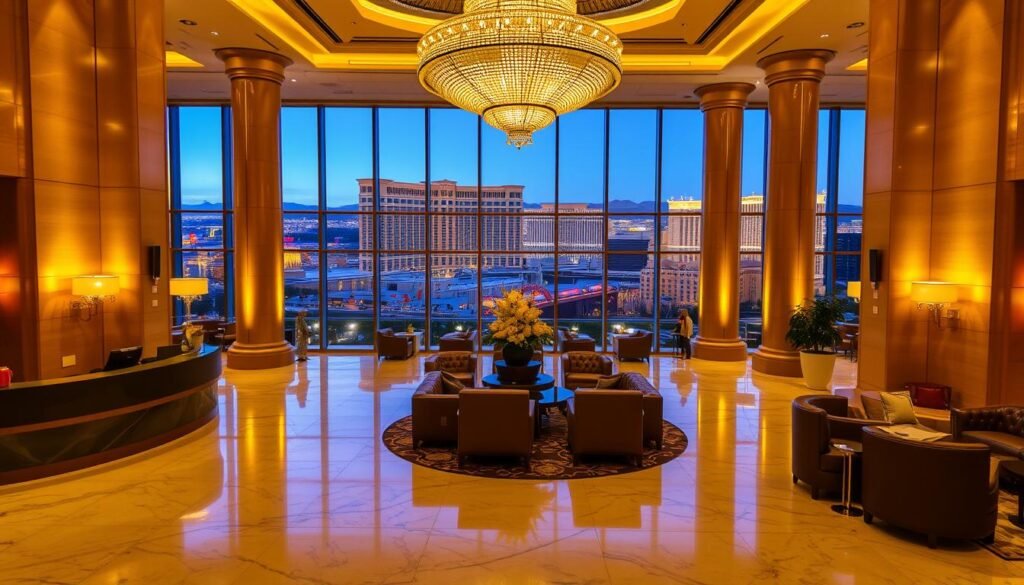
Convention calendars, mid‑week steals, and seasonal swings
Check the convention calendar first. Large expos inflate per night rates across the strip. Shift one day and you may find a dramatically lower rate.
- Aim for mid‑week stays to capture lower averages and upgrade chances.
- Anchor one splurge night when you want the city energy, then book value nights around it.
- Use the right credit card for late check‑out, elite perks, or dining credit that stacks with your stay.
- Watch holds release 4–6 weeks out—set alerts and be ready to pounce on better options.
| Factor | Impact | Action |
|---|---|---|
| Conventions | Large rate spikes across properties | Check trade show dates; move stay if possible |
| Weekday vs Weekend | Weekdays often cost less per night | Book Tue–Thu for value |
| Release window | Holds drop 4–6 weeks before | Set alerts; rebook fast |
“A smart calendar and the right card turn sticker shock into upgrade options.”
Credit, Status, and Perks: Maximizing Value at Expensive Hotels
Your card and your status matter more than you think when you book a suite-level stay. I test perks by stacking offers and watching what actually posts to the folio.
Stack perks smartly: book through a program that bundles breakfast, resort credit, or guaranteed late checkout. Those add real value without bumping the rate.
Mid-tier status often yields a welcome amenity and a nicer view. Top-tier status can push you toward upgrades or queue priority at check‑in desks and restaurant tables.
- Confirm dining credits and blackout dates before you plan a big table.
- Ask politely at check‑in—availability wiggle room exists outside peak windows.
- Use credits where they matter: spa treatments, tasting menus, or transfers.
| Perk | Typical Benefit | How to Use It |
|---|---|---|
| Breakfast credit | Daily meal allowance | Book mornings or redeem at signature restaurants |
| Resort credit | Spa, dining, parking offsets | Apply to experiences you value most |
| Late checkout | Guaranteed afternoon checkout | Schedule a relaxed departure or a final spa visit |
| Priority seating | Queue jump for tables | Mention status when booking restaurants |
“Stacking the right credits turns an indulgence into a calculated, higher‑value experience.”
Photography Style for This Guide: Editorial, Ultra‑Photorealistic Hotel Imagery
Good hotel photography puts you in the room before you arrive—warm light, true materials, and honest scale.
I shoot like we’re going to print: editorial frames that honor materials, light, and space. The aim is images that invite you to step across the floor and feel the room.
Photography style
Professional luxury hotel photography with a Condé Nast Traveler vibe—intimate, tactile, and editorial. I treat art, glass surfaces, and furniture as subjects, not props.
Technical specs
Canon EOS R5 + RF 24‑70mm f/2.8 at f/4.0, ISO 100, 1/125. Shoot 8K RAW for detail and latitude in post. Tack‑sharp focus and micro‑texture matter—stone, fabric, and metal should read true.
Lighting
Golden hour warmth (3500–4500K) softens tones. Mix ambient and window light with a professional three‑point kit to lift corners without killing mood. HDR balances bright windows and interior shadow.
Composition
Rule of thirds and leading lines guide the eye. Floor‑level lead‑ins and clean verticals give scale. Depth of field at f/4 keeps a crisp foreground and gentle background falloff.
- I shoot for editorial prints—8K RAW preserves micro‑texture while HDR keeps window views honest.
- Golden hour wraps rooms in warmth; three‑point lighting fills shadows and keeps the feel natural.
- Floor leads and verticals create a sense of space and feet‑level entry that draws you in.
“The result? Images that feel true—inviting, balanced, and ready to inspire your next stay.”
The most expensive hotel in las vegas: Which Property Fits Your Style?
Choosing the right place is less about sticker shock and more about how a stay feels from lobby to late‑night return.
If you want calm off the casino floor, Four Seasons or Waldorf Astoria offer non‑gaming serenity—quiet corridors, discreet service, and rooms that read like a restful home base.
For design‑hungry travelers, The Cosmopolitan brings artful energy and high‑floor terraces. It’s tactile, buzzy, and full of visual moments that reward sharp photography.
Prefer classic glamour? Bellagio still delivers fountain‑front theatrics and marble lobbies that photograph beautifully at golden hour.
Suite maximalists should look to Palms, Caesars, or Venetian/Palazzo. These properties stack space, private amenities, and dramatic finishes for nights that aim to impress.
Want a modern megaresort with breadth? resorts world stitches together multiple brands, deep dining options, and tech‑forward amenities—useful if you want variety without changing location.
| Guest Style | Best Property Match | Why It Fits |
|---|---|---|
| Non‑gaming calm | Four Seasons / Waldorf Astoria | Quiet lobbies, residential rooms, discreet service |
| Design driven | The Cosmopolitan | Artful interiors, high terraces, editorial energy |
| Classic elegance | Bellagio | Fountain views, marble finishes, timeless glamour |
| Suite theater | Palms / Caesars / Venetian | Large suites, private pools, theatrical layouts |
| New‑build sheen | resorts world | Multiple brands, dining depth, tech‑forward touches |
“Match your stay to the moments you want—quiet mornings, design shots, or a suite built for spectacle.”
Map Your Day: From Breakfast to Theater, With Time at the Pool
Start slow with a late breakfast that stretches into a sunlit stroll back to your rooms—then let the day take shape.
I build days around light and flow. Late breakfast with a view gives you a calm start. A slow walk across the resort grounds sets the pace for the afternoon.
Mid‑afternoon is pool time. I aim for after the peak heat—bright light, fewer crowds, better photos. A quick spa reset before evening keeps you fresh for the night.
Pre‑theater dining near the venue keeps the evening seamless. Pick a table that lets you step out right on cue. After the show, I drift through the casino for low‑stakes play if the mood hits.
Leave white space. World resorts reward spontaneity—a pop‑up bar, an art piece, or a last‑minute tasting can change your plans for the better. End with a quiet nightcap and a view of the skyline while you plot tomorrow.
| Time | Activity | Why it Works |
|---|---|---|
| Late morning | Breakfast with a view | Gentle start; sets the pace for the day |
| Mid‑afternoon | Pool + spa | Best light, fewer crowds, relaxed energy |
| Evening | Pre‑theater dining | Keeps timing tidy; fewer delays |
| Late night | Casino or nightcap | Wind down or chase the buzz |
“Design your day around light and pace—Las Vegas rewards a plan that leaves room for discovery.”
Conclusion
When city lights come up, the real measure of a stay reveals itself. I look for crisp signage, balanced blue‑hour light, and rooms that hold color. Those frames tell you more than a rate sheet about which expensive hotels match your mood.
Encore and Wynn still lead average rates, while palatial keys like the Palms Empathy Suite headline the ultra‑luxury tier. Resorts World changed the skyline—triple‑brand scale and broad amenities that reshape the resort map.
However you slice it, las vegas serves a spectrum—from premium rooms to once‑in‑a‑lifetime keys. Price per night is only part of the story; service, design, and how a place makes you feel write the rest.
Now you’ve got the lay of the land—pick your moment, lock the stay, and let the city surprise you.
FAQ
What defines the most expensive hotel on the Las Vegas Strip?
Price tags on the Strip hinge on suite size, bespoke services, private pools or gardens, celebrity‑designed interiors, and exclusive amenities like private theaters or butlers. I look at published nightly rates for flagship suites, plus resort fees and event‑driven surges to identify top contenders.
How do you compare suite prices across different resorts?
I base comparisons on a weeknight/weekend mix, the headline suite rate for a standard baseline, and include mandatory resort fees. Then I factor in major variables — conventions, sporting events, or headline residencies — that can spike costs dramatically.
Which suites currently top the list for sky‑high nightly rates?
The roster includes palace‑level penthouses and rooftop villas with private pools. Think Damien Hirst–designed penthouses, Nobu Villas, and multi‑room villas at Caesars and Resorts World — each offering 6,000–10,000+ sq ft, private amenities, and rates that run from the low thousands up to seven figures for ultra‑exclusive bookings.
Are nightly rates for these suites published or by inquiry only?
Many resorts list sample rates online, but the true price often requires direct contact. Some top suites are invite‑only or quoted per request because rates fluctuate with dates, special requests, and added services like private chefs or event staffing.
How much can baseline rooms cost on the Strip compared to suites?
Baseline room averages still run high. Properties like Encore, Wynn, and The Palazzo often show average nightly rates from the mid‑0s to 0s depending on season and events — a far cry from penthouse pricing but well above many other U.S. markets.
Is Resorts World Las Vegas really the largest recent build on the Strip?
Yes — it opened in 2021 as a roughly .3 billion development. The resort spans a 59‑story tower with over 3,500 rooms across Conrad, Crockfords, and Hilton brands, a 117,000 sq ft casino, a 5‑acre pool complex, and a 5,000‑seat theater.
Which neighborhoods on the Strip command higher rates — north end or center?
Rates vary by vibe. The north end tends toward newer luxury towers and exclusivity, while the center offers classic attractions and easy access to entertainment. Both can be pricey; your choice depends on whether you want privacy and modern design or proximity to major shows and fountains.
What extras typically justify a seven‑figure suite rate?
Private pools or gardens, full kitchens, in‑suite salons, dedicated staff, private screening rooms, and rare design commissions. Those elements create an experience that goes beyond size — they buy privacy, discretion, and a tailor‑made stay.
How do I time a booking to avoid huge rate spikes?
Watch convention calendars, big‑name residencies, and major sports dates. Midweek stays outside major events often yield better value. I also recommend booking refundable rates or calling the hotel to negotiate add‑ons like dining credits instead of paying a steep room rate.
Do non‑gaming luxury brands on the Strip offer better value?
Sometimes. Hotels like Four Seasons and Waldorf Astoria focus on service and quieter environments without a casino floor. If calm, privacy, and refined service matter more than gaming, those properties can feel like a smarter spend.
Can loyalty status or credit card benefits reduce the effective cost?
Absolutely. Elite status and premium credit cards can unlock upgrades, resort‑fee credits, late checkout, and dining or spa credits. Stack those perks and you often get far more value than the headline nightly price alone.
Are rooftop villas and private garden suites common at newer resorts?
They’re becoming more common as developers chase unique selling points. Resorts World, Nobu at Caesars Palace, and select properties offer private‑garden suites or rooftop retreats to attract high‑net‑worth guests seeking exclusivity.
How important is square footage when choosing a high‑end suite?
Square footage matters, but layout and amenities matter more to me. A well‑designed 6,000 sq ft suite with a private pool and theater beats a larger but poorly configured space. Look for usable outdoor areas and service access that preserves privacy.
What dining and entertainment features most influence a resort’s price point?
Signature restaurants by celebrity chefs, upscale nightlife, resident performers, and immersive theater venues all push rates up. Guests pay not just for a room but for access to culinary and entertainment ecosystems that define the resort’s identity.
If I want to photograph suites for editorial use, what should I request?
Ask for golden‑hour access, permission for tripods, and coordination with hotel PR for staging. Use low ISO, moderate aperture for depth, and balanced lighting — and request rooms with abundant window light and clean lines for that Condé Nast Traveler aesthetic.

